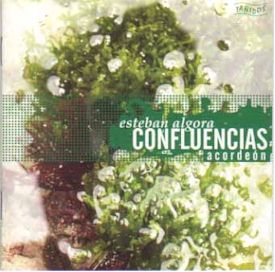The Free-Reed Review
Critiques of Compact Discs, Books and Music Scores
CD Review: Confluencias
Esteban Algora

Released: 2003
review date: February 2005
Several Records S.L. http://www.severalrecords.com
|
Index:
- Josê Ma Sánchez Verdú: Cuerpos deshabitados (2003)
- Josê Ma Sánchez Verdú: Schattentanz (2003)
- Alfonso Casnova: Confluencias (2001)
- Enrique Igoa: Torcal Op. 32 (1997/98)
- Josê Ma Sánchez Verdú: Dhamar (2000)
- Eduardo Polonio: La Última Pócima (2002)
- Alberto Posadas: Snefru (2002)
- Andrés Lewin-Richter: Secuencia XIII (2002)
- Guiherme Carvalho: A reta é um espaco métrico completo (2003).
Performers
- Esteban Algora; free bass accordion
- Saioa López: soprano voice
- Andrés Gomis: saxophone
- Isabel Puente: piano
- Ludwig Carrasco: violin
- Eduardo Soto: cello
- Guilherme Carvalho: cello
- Sophie Dardeau: flute
- Ivan Solano: clarinet
- Elisa Humanes: percussion
- Avelina Vidal: guitar
|
Review by: Steve Mobia
As more contemporary composers explore the unique character of the
accordion, the broader its context as a concert instrument and the less
stereotyped it's image. This wonderful recording by Spanish
accordionist Esteban Algora, serves to celebrate the accordion as a
producer of a sonic world completely devoid of the usual nostalgic
trappings of the repertoire. It is a fiercely experimental album and
not for those seeking comfort or familiarity but is instead an intense
and carefully executed program of avant-garde works by Spanish
composers.
The disc commences with two haunting pieces from a chamber opera by
Josê Ma Sánchez Verdú and features the soprano voice of Saioa López.
Uninhabited Bodies and Shadows
Dance both use breath, harmonics and charged
incantation-like repeated figures with rattles and other
non-pitched sounds. The result is hypnotic and highly theatrical.
The title piece Confluences by Alfonso
Casanova explores the extreme ends of the accordion's range. It's an intense ride as high shrill and
low growling passages intersect and collide showering the ears with
aural sparks. The only equilibrium that arises is a unison pitch (an
F#) which culminates the work.
A radiant lightness pervades Enrique Igoa's
Torcal for accordion and
guitar. It's the most obviously Spanish on this disk which occasional
echoes of Flamenco on the guitar. The precise and playful give and
take between instruments propels this piece along through a variety of
moods and recurring melodic fragments. The title refers to a
geological erosion of limestone rock.
Dhamar is an astonishing duet between
accordion and saxophone and is the third included piece by gifted composer
Josê Ma Sánchez Verdú.
Unlike the previous duet, the two instruments here merge into each
other, forming some other sonic creature, it's character slowly
unfolding in always surprising ways. Often, the sax playing
multiphonics acts as an aura around the accordion's shimmering tremolos
or sustained basses. Both seem to return to a kind of primal source.
Breathing and non-pitched sounds are used artfully and with expressive
care.
The Last Potion for accordion and tape by
Eduardo Polonio begins with
an epileptic accordion solo against a soft background of electronic
sounds. Then the piece settles into a meditative stretch of very quiet
signaling. Suggests a kind of extraterrestrial communication
exercise.
Alberto Posadas' Snefru is another one for
accordion and electronics
albeit on a grander scale. The composer describes using mathematics
evidenced in the design of the Egyptian pyramids and applying it to the
sound materials. Fascinating textures result. The exploration of
micro-intervals in the electronic part is especially impressive.
Though I can't attest to it's mathematical construction, as a
compelling sound experience it very much succeeds.
In Secuencia XIII Andrés Lewin-Richter
presents a more melodic
accordion part over a watery, shimmering, ever flowing electronic part.
Often the melodic material sticks to regular rhythmic values as
opposed to the liquid electronic presence. At other times the
electronics mimic passages on the accordion and vice versa. The piece
certainly has an abundance of ideas.
The final track's title translates as The line is a complete
metric
space. Guilherme Carvalho's piece is for accordion, clarinet,
cello, flute and percussion and explores varieties of musical density.
It's a somewhat austere listen, mostly redeemed by the excellent
musicianship of the delivery. Recorded live at a concert in Paris.
The recording quality is generally good except for the live final
track with has some digital distortion in the loud sections. The booklet is
informative and gives impressive bios of the composers. With this
audio document, Esteban Algora joins the growing ranks of virtuoso
players expanding the sound world of the accordion and it's
repertoire.
